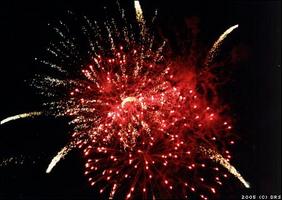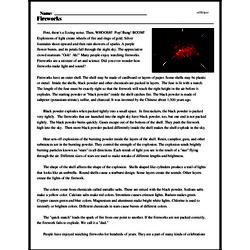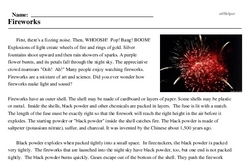Fireworks
First, there's a fizzing noise. Then, WHOOSH! Pop! Bang! BOOM! Explosions of light create wheels of fire and rings of gold. Silver fountains shoot upward and then rain showers of sparks. A purple flower bursts, and its petals fall through the night sky. The appreciative crowd murmurs "Ooh! Ah!" Many people enjoy watching fireworks. Fireworks are a mixture of art and science. Did you ever wonder how fireworks make light and sound?
Fireworks have an outer shell. The shell may be made of cardboard or layers of paper. Some shells may be plastic or metal. Inside the shells, black powder and other chemicals are packed in layers. The fuse is lit with a match. The length of the fuse must be exactly right so that the firework will reach the right height in the air before it explodes. The starting powder or "black powder" inside the shell catches fire. The black powder is made of saltpeter (potassium nitrate), sulfur, and charcoal. It was invented by the Chinese about 1,500 years ago.
Black powder explodes when packed tightly into a small space. In firecrackers, the black powder is packed very tightly. The fireworks that are launched into the night sky have black powder, too, but one end is not packed tightly. The black powder burns quickly. Gases escape out of the bottom of the shell. They push the firework high into the sky. Then more black powder packed differently inside the shell makes the shell explode in the sky.




